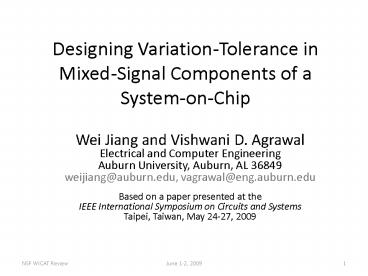Designing Variation-Tolerance in Mixed-Signal Components of a System-on-Chip PowerPoint PPT Presentation
Title: Designing Variation-Tolerance in Mixed-Signal Components of a System-on-Chip
1
Designing Variation-Tolerance in Mixed-Signal
Components of a System-on-Chip
- Wei Jiang and Vishwani D. Agrawal
- Electrical and Computer Engineering
- Auburn University, Auburn, AL 36849
- weijiang_at_auburn.edu, vagrawal_at_eng.auburn.edu
- Based on a paper presented at the
- IEEE International Symposium on Circuits and
Systems - Taipei, Taiwan, May 24-27, 2009
2
Motivation
- Process variation in nanoscale technology
- Catastrophic faults
- Parametric faults, more than before, cause
- Degraded performance
- Yield reduction
- Built-in self-test and self-calibration
- Test and diagnosis
- Device calibration
- Characteristics measurement
- On-chip error correction
3
Mixed-Signal Devices Under Test
Devices Under Test
Portions of a typical wireless transceiver SoC.
4
Mixed-Signal Components and Errors
- Mixed-signal Devices on SoC
- Analog-to-digital converter (ADC)
- Digital-to-analog converter (DAC)
- Non-linearity errors in kth output
- Differential non-linearity (DNL)
- Integral non-linearity (INL)
- where LSB magnitude of least significant bit
5
A Conventional Mixed-Signal BIST Architecture
Devices Under Test
See, F. F. Dai and C. E. Stroud, Analog and
Mixed-Signal Test Architectures, Chapter 15, p.
722 in System-on-Chip Test Architectures
Nanometer Design for Testability, Morgan
Kaufmann, 2008.
6
Proposed BIST Scheme
7
DAC Output Measurement (Off-Line)
- The on chip DSP provides all codes to the DAC
under test. - A 1-bit S? modulator does A-to-D conversion.
- High linearity due to oversampling and noise
shaping technique. - Assumption S? modulator is fault-free because of
its simple structure and good tolerance for
quantization errors. - S? is modulator is deactivated during normal
system operation no performance impact on SoC. - Use of higher-order S? modulator may have
advantages, to be investigated.
8
Polynomial Fitting Algorithm (Off-Line)
- Fitting INL error of DAC output
- Third-order polynomial as, yb0b1xb2x2b3x3
- A simple algorithm partitions DAC outputs into
four equal-sized sections and calculates sums for
each section. - Obtaining four polynomial coefficients from the
sums - Characteristics of DAC (offset, gain, 2nd and 3rd
harmonic distortions) can generally be identified
with these coefficients. - Higher degrees for the polynomial can be used if
an adaptive fitting algorithm is used. - The fitting procedure is off-line, done
- At system startup, after digital BIST for DSP is
completed. - Periodically when system is idle, to continuously
update fitting polynomial
S. K. Sunter and N. Nagi, A simplified
Polynomial-Fitting Algorithm for DAC and ADC
BIST, Proc. of International Test Conference,
1997, paper 16.2. W. Jiang and V. D. Agrawal,
Built-in Adaptive Test and Calibration of DAC,
Proc. IEEE 18th North Atlantic Test Workshop, May
2009, pp. 3-8.
9
DAC Output Correction (On-Line)
- Stored polynomial coefficients are stored in
digital registers by off-line measurement. - Correction for analog INL error for each digital
input are generated by a low-resolution dithering
DAC - This limits the INL error in the calibrated DAC
output to within 0.5 LSB. - To avoid nonlinearity errors within
dithering-DAC, dynamic element matching (DEM)
techniques may be investigated.
10
More Details and Subsequent Work
- Testing of on-chip ADC
- Use calibrated DAC to test and characterize
on-chip ADC under test. - For details, see Proc. ISACS09.
- Also see, W. Jiang and V. D. Agrawal, Built-in
Self-Calibration of On-Chip DAC and ADC, Proc.
International Test Conference, 2008, paper 32.2. - Later work,
- W. Jiang and V. D. Agrawal, Built-in Adaptive
Test and Calibration of DAC, Proc. 18th IEEE
North Atlantic Test Workshop, May 13-15, 2009,
pp. 3-8.
11
A 14-Bit DAC with Nonlinearity
INL of 14-bit DAC (LSB)
Indices of 14-bit DAC-under-test
- 16K ramp codes
- Maximum INL error up to 1.5 LSB
12
Polynomial Fit and Calibrated DAC
- Polynomial fitting for DAC output
- 6-bit low cost dithering-DAC
- INL error reduced to 0.5LSB
INL of 14-bit DAC (LSB)
Indices of 14-bit DAC-under-test
13
Conclusion and Future Work
- Proposed technique
- Uses simple devices for a post-fabrication
technique to improve system reliability against
process-variation. - Off-line built-in fault-detection and parameter
characterization. - On-line at-speed self-correction for nonlinearity
errors. - Future Work
- Reliable self-test for test and calibration
circuitry (sigma-delta modulator, dithering DAC,
etc.) - Generalize the polynomial interpolation of INL to
higher degree polynomials.
14
Thank you
- Authors will appreciate your questions or
comments. - Please write to
- Wei Jiang, weijiang_at_auburn.edu
- Vishwani D. Agrawal vagrawal_at_eng.auburn.edu

